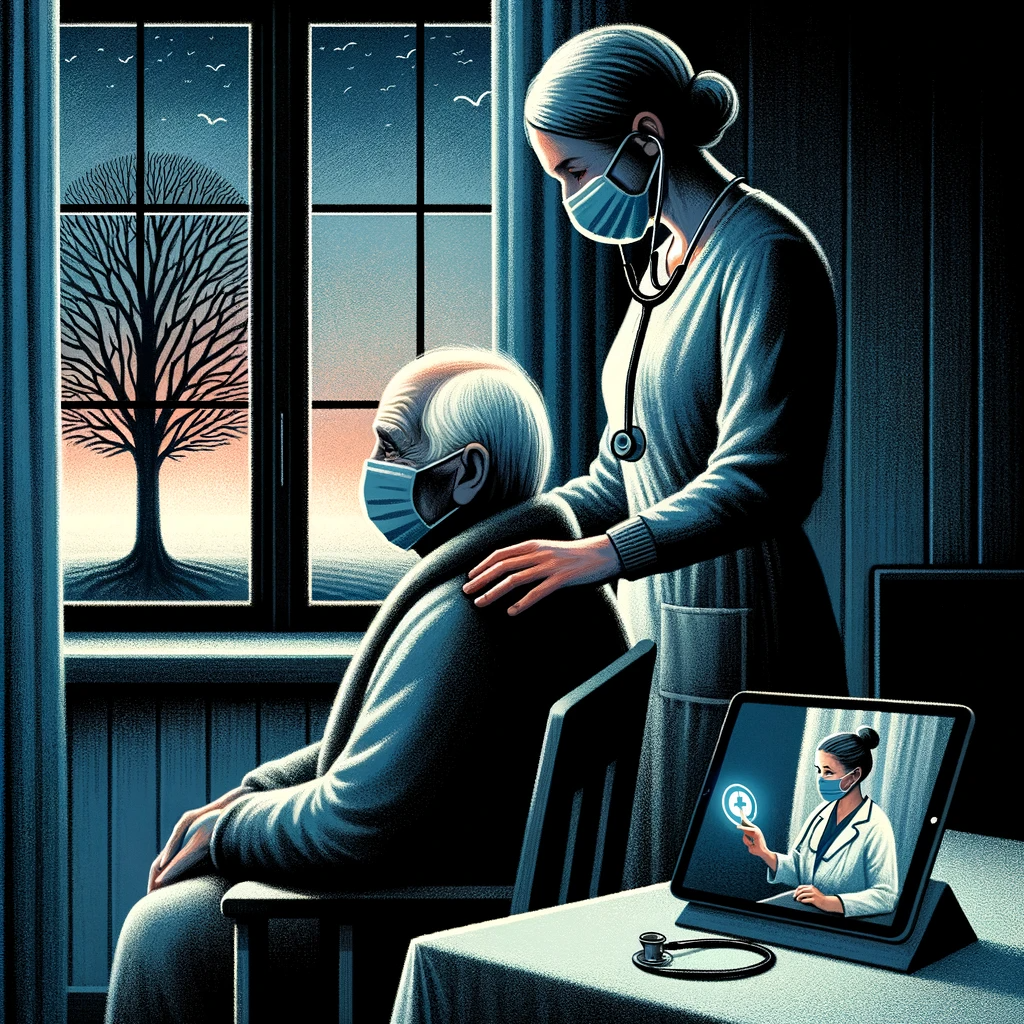Critical Insights: What Did the Pandemic Teach Us About Fixing the Caregiving System
he pandemic highlighted mental health issues in caregivers and seniors, with stress and loneliness from isolation and caregiving. It revealed a shortage of trained caregivers, pushing telehealth growth and emphasizing crisis preparedness.

The pandemic shed light on the fragility of our caregiving systems, striking at the very core of our social fabric. It taught that robust, compassionate healthcare structures are not just ideal; they’re critical. In this article, we distill what did the pandemic teach us about our healthcare’s hidden fault lines and the resolve needed to mend them. Expect to delve into the intricate balance of mental health, staff shortages, and financial strain that came to the fore in these unprecedented times.
Key Takeaways
The pandemic exposed significant mental health challenges for caregivers and seniors, with increased stress, anxiety, depression, and loneliness due to social isolation and the heavy toll of caregiving duties.
There was a critical shortage of well-trained caregivers for hire, which strained memory care and home health care services, leading to expanded telehealth services and lessons on the necessity of preparing for future health crises.
Efforts to address the caregiver crisis post-pandemic are vital, focusing on managing caregiver burnout, overcoming social isolation, and utilizing advanced technology to assist seniors aging in place.
The Impact of COVID-19 on Mental Health of Caregivers and seniors

The pandemic has significantly highlighted mental health challenges among caregivers and seniors. Overwhelmed health care systems, social distancing measures, and the fear of a novel virus have exacted a heavy toll on their mental well-being, while also putting a strain on their immune system.
As the global pandemic unfolded, caregivers and seniors grappled with stress and anxiety, with concerns ranging from health risks to the pressures of caregiving amidst a global crisis.
Stress and Anxiety
The pandemic introduced unexpected stressors, leading to heightened anxiety among caregivers and seniors. Worries about COVID-19 health risks and extra pressure from caregiving duties led to heightened stress levels. This stress further exacerbated existing health problems and, in some cases, led to new ones.
This situation firmly reminds us of the significant role mental health plays in our overall well-being.
Depression and Loneliness in Seniors and Family Caregivers
During the pandemic, depression and loneliness became increasingly prevalent among seniors and caregivers. Isolation measures, while necessary for disease control, had the unfortunate side effect of increasing feelings of loneliness and depression. For seniors living alone, the isolation was particularly harsh, leading to higher rates of depression.
A sharp increase in depression levels among the senior population and family caregivers, observed for more than a decade, provided evidence of this.
The Lack of Workplace Support For Family Caregivers
Beyond the emotional toll, the pandemic amplified the need of workplace support for family caregivers. Juggling work demands with caregiving responsibilities, many caregivers found themselves stretched thin and struggling to maintain a work-life balance.
The lack of support from workplaces added to the existing stress, making the caregiving journey even more challenging.
The High Financial Cost of Caregiving on Families
The pandemic further highlighted the financial pressure on families engaged in caregiving. The costs associated with caregiving were already high before the pandemic. However, the crisis further compounded these costs, leading to significant financial losses for families.
Beyond the emotional and physical toll, the financial burden intensified the stress for caregivers.
A shortage of well-trained, reliable caregivers for hire

The pandemic also spotlighted the shortage of competent, reliable caregivers for hire. The rapidly aging population, coupled with staffing problems in home care agencies, led to a strain in the caregiving sector. Not to mention, the physically and emotionally demanding nature of the job added to the issue.
This shortage had a ripple effect on various aspects of healthcare services.
Strained Memory Care Units and Home Health Care
Memory care units and home health care services faced the brunt of the caregiver shortage. The demand for these services increased, but the lack of caregivers led to a strain, compromising the quality of care provided to seniors.
Telehealth Expansion
Despite the challenges, the caregiver deficit also created opportunities for innovation. Telehealth services expanded to fill the gap, providing essential health care support for seniors and their families.
Due to the shortage, telehealth services became increasingly crucial, especially for those in remote areas.
Lessons for Future Crises
While the pandemic was devastating, it offered valuable lessons for future crises. Some of these lessons include:
The importance of addressing the caregiver shortage
The need for support systems for those in need
The necessity of preparing for future healthcare crises
The need for improved support services for caregivers
The need to address the lack of transportation services available in suburban and rural areas
These lessons can help guide us in better managing and responding to future challenges, including everyday tasks.
The pandemic emphasized the significance of planning and communication for the well-being of seniors and caregivers.
Addressing the Caregiver Crisis Post Pandemic
As we transition into a post-pandemic world, tackling the caregiver crisis continues to be a priority. The pandemic served as a catalyst, bringing to light the challenges faced by caregivers and highlighting the need for more supportive policies and systems.
Challenges and Burnout of family caregivers and direct care workers
Family caregivers and direct care workers faced a myriad of challenges during the pandemic. Some of these challenges included:
Burnout: Many caregivers experienced physical and emotional exhaustion from the demands of their roles.
Lack of support and resources: Caregivers often lacked the necessary support and resources to effectively carry out their responsibilities.
High turnover rate: The combination of burnout and lack of support led to a high turnover rate among caregivers.
Addressing the growing social isolation of seniors and their caregivers
Another key aspect in the post-pandemic world is addressing the social isolation of seniors and caregivers. The pandemic exacerbated feelings of isolation among seniors and their caregivers, contributing to mental health issues like depression and anxiety.
Efforts have been made by the scientific community to tackle this issue by promoting social activities and building connections.
Community Support and Connection

During the pandemic, community support and connection surfaced as a ray of hope. They played a crucial role in providing a safety net, offering support and resources to caregivers and seniors, making the challenges of the pandemic more bearable.
Virtual Communication Tools
Virtual communication tools turned into an integral part of maintaining connections during the pandemic, as they allowed people to feel like they were in the same room with their loved ones. They helped seniors stay connected with loved ones and alleviate emotional distress, providing a lifeline in the midst of isolation.
Grassroots Initiatives to Address the Growing Caregiver Crisis
Grassroots initiatives stepped up to address the caregiver crisis, providing much-needed support and resources. These initiatives provided essential interventions, information, and direct support, easing the burden on the caregivers. There needs to be an ongoing public education and the need of support for the family caregiver.
Essential Insights: Lessons from the Pandemic on Enhancing Caregiver Support and Transportation Solutions
The global pandemic has cast a spotlight on various societal issues, including the challenges faced by caregivers and the elderly, particularly in the realm of transportation. A notable concern is the struggle to transport loved ones to essential destinations such as medical appointments and social gatherings. A 2018 survey by the National Aging and Disability Transportation Center revealed that approximately 40% of caregivers devote a minimum of five hours weekly to managing or providing transportation. This lack of transportation options not only poses logistical difficulties but also contributes to feelings of isolation among the elderly, which can escalate the risk of serious health conditions.
Several community transportation initiatives exist to alleviate this burden. Programs like Dial-A-Ride, supported by local governments, cater to individuals over 65 or those qualifying under the Americans With Disabilities Act. Additionally, organizations like Shepherd’s Centers of America mobilize volunteer drivers to assist in transportation needs.
While Medicare typically covers only emergency medical transport, recent changes have enabled more Medicare Advantage plans to include transportation benefits. This shift saw a 25% increase in such benefits in 2020, as reported by the Medical Transportation Access Coalition.
Innovative solutions have also emerged. For instance, Denver Health collaborated with Lyft in 2017 to provide patient transportation, particularly after an incident where an elderly patient lacked timely transport. This program, funded by the Denver Health Foundation, offers crucial transport services, especially for patients without other options.
Similarly, San Antonio’s SafeRide Health has partnered with Lyft to streamline transportation arrangements through user-friendly software. Their goal is to simplify access to transportation with a single click, ensuring patients can easily secure a ride to their appointments.
These advancements demonstrate a growing recognition of the need for improved transportation services for caregivers and the elderly, particularly as the population ages. The pandemic has highlighted this critical aspect of caregiving, underlining the importance of accessible and efficient transportation solutions in supporting the health and well-being of our communities. This is another area that the private sector should step to the plate and adresse in their communities.
Dementia Care During the Pandemic

Dementia care experienced significant impacts during the pandemic. With increased negative symptoms, caregiver support challenges, and the need for digital technologies to enhance care, dementia care faced unique challenges.
Increased Negative Symptoms
Seniors with dementia experienced increased negative symptoms during the pandemic, highlighting the need for additional support and resources.
Caregiver Support
Caregiver support for those with dementia was crucial during the pandemic. Family members and professionals faced unique challenges as they navigated the uncertain waters of dementia care during a global crisis. The majority of family caregivers felt abandoned and helpless, leading to further mental health decline
Digital Technologies for Dementia Care
Digital technologies emerged as valuable tools for dementia care during the pandemic. They helped enhance the lived experience of those with dementia and provide much-needed support for caregivers. These digital technologies were limited and many caregivers did not have the knowledge to take advantage of these technologies.
Lessons in Adaptability and Resilience
The pandemic taught valuable lessons in adaptability and resilience. These lessons, including personal growth, business adaptation, and policy changes, provide a roadmap to support caregivers and seniors in the future.
Personal Growth and Well-being
During the pandemic, personal growth and well-being were vital for caregivers and seniors. Many were increasingly challenged to focus on self-care and stress management. So many family caregivers continued to find the silver linings amidst the crisis.
Business Adaptation to Address the Needs of Direct Care Workers and Family Caregivers
Businesses tried to adapt to address the needs of direct care workers and family caregivers during the pandemic.
They demonstrated resilience and innovation by:
Improving communication
Setting clear plans
Reviewing sick leave and remote work policies
Offering flexible work arrangements
Providing resources and support
Creating an awareness that is a need for a more supportive culture for caregivers.
Employers have a long way to go to support the family caregiver. In order for companies to survive, they are going to have to get creative
Changing Policy to Encourage a National Movement to Encourage Building Care Team Partner Support Groups
Policy changes need to create a national movement to establish Care Team Partner Support Group to provide practical support for care recipients and the family caregiver. These groups would provide practical support for caregivers and their care recipients, highlighting the importance of community support and connection and education of the needs of the family caregivers.
Addressing the Caregiver Crisis
Mitigating the caregiver crisis involves expanding advanced technology to assist seniors aging at home, ensuring access to affordable respite care, and promoting ongoing technological advancements, employer programs to address the needs of the working caregiver. The financial aspect of family caregiving must be addressed. The family caregiver provides over $650 billion dollars of unpaid care.They do so at the detriment of their own physical, mental and financial well being. While government policy makers are talking about creating tax benefits for the family caregiver, this is unacceptable. There must be a focus on financially supporting the family caregiver,
The family caregiver provides care for years. They pay many out of pocket expenses and no income. As they are taking care of their loved ones, they are unable to save for their own future. Those providing care for people with dementia are impacted with providing the best possible care at home as they try to avoid an admission to a memory care unit.
We also are seeing the government policy makers create Medicare programs that include cost sharing. These changes will have a devastating impact of the care recipient, the family caregiver and the communities they live in. The high copays, high deductibles and cost rising out of pocket expenses impact the care provided for every single person needing care.
I recently was helping a family caregiver find the right program for his wife to receive therapies in a skilled care unit. While we were waiting, I heard a woman gasp and then start sobbing. She has just learned that the Medicare Advantage plans cost sharing for this benefit was to be $250 a day. The recommended treatment by the doctor was now being questioned. How does a family caregiver provide the necessary care? The pressures that are being placed on the unpaid family caregiver is not sustainable. I recently read an article of how the wealth of the baby boomers.
Here's what I learned
The Impact of Medicare Cost-Sharing on Inheritance and Wealth Transfer from Baby Boomers to Millennials and Gen X
The increasing cost-sharing responsibilities imposed by Medicare are set to significantly affect the wealth transfer from Baby Boomers to younger generations, particularly Millennials and Generation X. As Medicare shifts more financial responsibility to consumers, out-of-pocket healthcare expenses for the elderly are on the rise. This trend could reduce the amount of inheritance left to younger family members.
Traditionally, wealth transfer from older generations has been a significant source of financial stability for younger people. However, with Baby Boomers now facing higher healthcare costs in their later years, the expected inheritance for Millennials and Gen X may be substantially lower. The escalating medical expenses, which include costs not covered by Medicare, must often be paid out-of-pocket, diminishing the savings and assets that Boomers can pass down.
This shift not only impacts the direct financial inheritance but also influences the overall financial planning strategies of younger generations. Millennials and Gen X might need to adjust their expectations regarding family inheritance and focus more on personal savings and investments to secure their financial future.
In summary, the growing burden of healthcare costs on the elderly, exacerbated by Medicare’s cost-sharing policies, is poised to reshape the landscape of wealth transfer across generations. As a result, younger generations may find themselves with reduced financial legacies, prompting a need for revised financial planning and savings strategies.
Growth of Advanced Technology to Support Seniors Aging in Place
Advanced technology has the potential to support seniors aging in place. By enhancing the safety and independence of seniors, these technologies can reduce the burden on caregivers and improve the quality of life of seniors.

Access to Affordable and Regular Respite care
Access to affordable respite care is crucial in supporting caregivers and seniors. It provides temporary relief and support, allowing caregivers to rest and recuperate while ensuring that seniors continue to receive the care they need. At the present time, the majority of family caregivers are not able to afford respite care services. The reality is, the caregiving journey, on average is 6 to 8 years. Some provide care for 20 years or longer.
While the large disease specific organizations raise billions of dollars for finding cures, they have ignored the growing caregiver crisis. The stress and burden of caregiving statistics were bleak when I started my first site over 20 years ago. Then, 50% of family caregivers became seriously ill or died before the family member they were caring for passed. This is now at 63%. With the changes in the Medicare plans going to a cost sharing platform and rationing of care already occurring, the future health of every family caregiver is at risk. We must act and act now. It is time for family caregivers and a cure for caregiver stress and burden be addressed.
The Growing Need for Technology Advancement to Support Aging in Place
Japan has been preparing for their aging crisis by developing caregiver robots and other technologies for the past 20 years. Continued technological advancements are needed to support aging in place. As the population continues to age, the need for innovative solutions to support seniors and caregivers will continue to grow. I am seeing family caregivers coming up with solutions for the challenges and obstacles they faced. It will be the ingenuity of the private sector that will help us overcome the challenges face everyday.
Silver Linings and Hope for the Future
Despite the difficulties, the pandemic has offered glimmers of hope and positive aspects for our daily life in the future. These include a renewed appreciation for nature and opportunities for personal growth and reflection, where happiness lies.

Appreciation for Nature
The pandemic has fostered an increased appreciation for nature. Many found solace and relief in outdoor activities and natural environments. I am hopeful that technology will bring nature and wonderful outdoor experiences to the lonely elders and disabled with amazing VR experiences
Personal Growth and Reflection
During the pandemic, personal growth and reflection have been critical for caregivers and seniors. Many have learned valuable lessons in resilience, adaptability, and self-care.
Summary
The pandemic has been a challenging time for everyone, particularly for caregivers and seniors. However, it has also provided us with opportunities to learn, grow, and adapt. From highlighting the importance of mental health and the need for well-trained caregivers to the power of community support, these lessons have the potential to reshape the caregiving system for the better. As we move into a post-pandemic world, these insights will continue to guide us, offering hope for a better future for caregivers and seniors alike.
Frequently Asked Questions
What our society has learned from the COVID-19 pandemic?
During the COVID-19 pandemic, we have learned the significance of maintaining social connections and utilizing technology to stay in touch. It has also emphasized the importance of implementing effective policies to protect public health and well-being.
How did the pandemic change us?
The pandemic changed us by altering the way we live and our abilities. It affected our motivation to learn and experience new things, while also shifting our appreciation for human connection and remote work. While the worst of the pandemic may be over, its effects continue to linger.
How has the pandemic affected the mental health of caregivers and seniors?
The pandemic has significantly impacted the mental health of caregivers and seniors, leading to increased stress, anxiety, depression, and loneliness due to various factors such as health concerns, isolation, and caregiving responsibilities. It's important to recognize and address these challenges.
What was the impact of the caregiver shortage during the pandemic?
The caregiver shortage during the pandemic led to increased demand and challenges in memory care units and home health care services, prompting the expansion of telehealth services to fill the gap. It has significantly affected the availability and quality of caregiving.
What are the silver linings and hopes for the future post-pandemic?
The pandemic has brought about a renewed appreciation for nature, opportunities for personal growth, and insights that can guide the reshaping of the caregiving system for the better. There are silver linings and hope for the future post-pandemic.
All of our guides, downloads, worksheets, Premium courses
Click Subscribe To Get Started.
You might also like this article:


